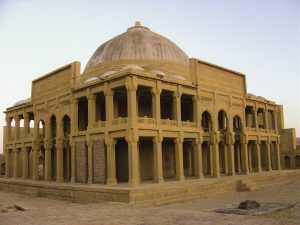
Ramkot Fort. Hindu temple
October 26, 2021
Khaplu Fort, Architectural heritage
October 26, 2021
Makli Necropolis
Numerous archaeological sites all across Pakistan either withstood the test of time or have been excavated, and remain as majestic landmarks for tourists to wonder about. Makli Necropolis is among some of the most captivating archeological sites not only in Pakistan but in the entire world.
People mostly heard about Mohenjo Daro or Harappa, an ancient city of Indus Valley Civilization but people are not much aware of one of the oldest and largest necropolises in the world lies in Thatta city of Sindh province of Pakistan that features several large funerary monuments, belonging to various Sufi saints, royalties, and esteemed scholars. The graveyard stretches over an area of 10 square kilometers having graves made of boulders and plastered with lime chiroli. It houses approximately 500,000 to 1 million tombs built throughout 400 years. All their graves have turned out to be the largest graves ever. It is estimated that among the cemetery’s residents, nearly 125,000 of them were saints who belong to Religion Islam. The tombs were built over a long period, about a period of 400 years by the Sindh civilization between the 14th and 18th centuries.
There are numerous myths regarding the name of this graveyard. According to sources, the Makli Necropolis is named after a pious woman, Mai Makli whose prayers were answered by Allah and this prevented Firoz Shah Tugluq from conquering Thatta. The locals admired her and she was buried at this graveyard.
According to another account, the pilgrim returning from Makkah stayed at this place, upon seeing a mosque just outside the Thatta city, fell into a state of ecstasy, and called it little Makkah. After this incident a famous Sufi saint, Sheikh Hamad Jamali named this graveyard Makli. This saint is believed to be the first person to be buried at this graveyard.
The graveyard is an almost diamond-shaped enclosure on the hill that is divided into two major clusters, the Samma period in the northern area and the Arghun/Tarkhan/Mughal period along the southern border. The city of Thatta flourished during the Samma period because they were the first master-builder of Makli whereas the architecture during the Arghun/Tarkhan/Mughal period was more significant.
The structures, built of stone and brick, are notable for their fusion of diverse influences into a local style, for example, a blend of Muslim, Persian, Gujrati, Mughal, and Hindu architectural designs. Some of the tombs feature cravings of animals, warriors, and weaponry. One of the most outstanding tombs in this graveyard is that of the ruler of the Samma dynasty, Jam Nazimuddin 2. It is made up of sandstone and embellished with floral and geometric medallions. The outer walls have a brand of motifs that features Quranic verses and Hindu symbols. The tomb of Jan Beg Tarkhan is decorated with ceramics, the dome is covered with blue and turquoise glazed tiles.
Tourists visit this site for historical appeal. The site was inscribed as a UNESCO World Heritage Site in 1981 as an “outstanding testament” and a glimpse into the lost civilization of Thatta
